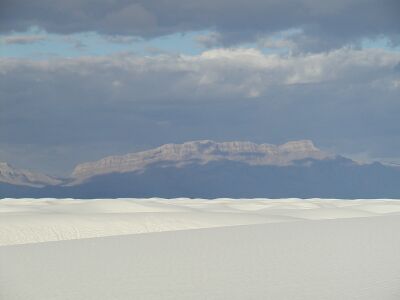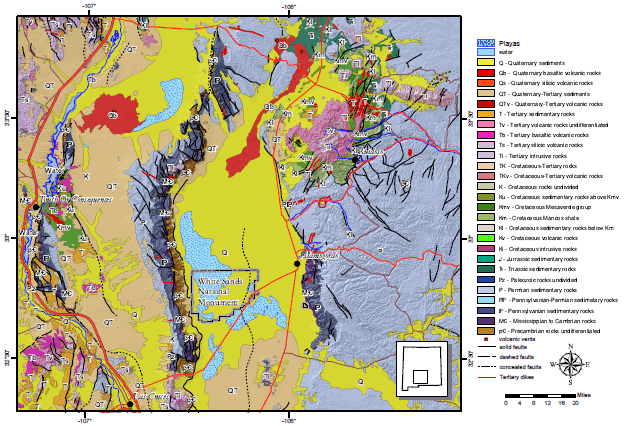
General Geology
Tularosa Basin

White Sands lies in the Tularosa Basin. The gypsum that forms the white sands was deposited at the bottom of a shallow sea that covered the region 250 million years ago during the Permian era. Over time the gypsum-bearing marine deposits like the Yeso and San Andres formations were turned into stone. 70 million years ago mountain building took place that uplifted the Rockies and elevated the western states. This upheaval called the Laramide Orogeny caused the present Tularosa area to be uplifted into a broad arch. Around 10 million years ago the crust began to stretch apart and the Tularosa arch began to subside to form the Tularosa Basin, and the Sacramento Mountains to the east and San Andres mountains to the west were uplifted along north-south trending faults.

The Tularosa Basin is called a graben, and a "bolson" because it has no outlet for surface water. It is like a bathtub with no drain. After summer thunderstorms Lake Lucero fills with runoff from the San Andres Mountains. As the playa lake evaporates gypsum crystallizes and is deposited on the lake floor, to be picked up by the winds and carried to the dune fields.
Gypsum
The common mineral gypsum is a hydrous form of calcium sulfate (CaSO4.2H2O). It is rarely found in the form of sand because it is soluble. Gypsum is typically very soft, a '2' on the hardness scale (1=talc, 10=diamond). Our fingernails are a hardness of 2.5, so our nails can scratch gypsum. It dissolves in water into calcium ions and sulfate ions.
Gypsum is an evaporite mineral: The calcium and sulfate ions when sufficiently concentrated due to the evaporation of water, recombine and precipitate out into gypsum or anhydrite. Gypsum comes in many forms.The crystal form is called selenite. Very fine grained gypsum is called alabaster and is used for sculpting.
Gypsum is one of the oldest building materials in the world. Modern uses include casts for setting broken bones (if you heat up gypsum and drive out most of the water you get Plaster of Paris), wallboard, cement setting retardant, paint, soil conditioner, crayons, even put in beer to help enzyme action and yeast fermentation.
Wind Transportation
As the gypsum sand-sized (0.06-2mm) grains are moved by the wind they are reduced in size due to frequent collisions with other grains and the desert surface. The softness and perfect cleavage of gypsum aids this process. Deposition of the gypsum occurs whenever the wind slackens.
At wind speeds of 12m.p.h (19 km.p.h) grains of gypsum swirl against boots.
At 20 m.p.h (32 km.p.h) wind piles sand higher and steeper on the crest of dunes, within an hour nearly 5 cm (2") of new deposits will crown some of the dunes. The air is now filled with dust and blowing gypsum.
Gusts of 35-40 m.p.h (55-65 km.p.h) carry pieces of broken shrubs across the plain.
The wind's direction during major sandstorms will rotate steadily clockwise as it blows first from the southwest and west, then diminishes from out of the northwest and north, and fianlly dies as an easterly breeze.


